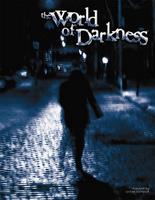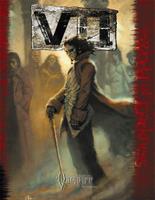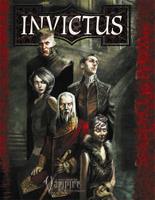Storytelling Games as a Creative Medium

Will Hindmarch contests Greg Costikyan's challenge to the idea that "games have something to do with stories" by contending that "storytelling games reconcile the theoretically antithetical relationship between their two halves - story and game."
White Wolf Publishing’s Vampire: The Requiem is the boy king of storytelling games, successor to father and founder Vampire: The Masquerade.
For fifteen years, Vampire in its various editions has been one of the most successful paper-based role-playing game (RPG)properties, second only to the lingua franca of the hobby, Dungeons & Dragons. Vampire is perhaps best known for attracting large numbers of new players to the role-playing game hobby with its dramatic, modern gothic style and emphasis on narrative rather than game mechanics.Owing to the company’s almost sole use of the phrase “storytelling game” in marketing, one might presume that a storytelling game is simply any role-playing game published by White Wolf, but that’s not strictly accurate. In the Storytelling System rulebook, “Storytelling System” is claimed as a trademark of White Wolf Publishing, Inc., but “storytelling game” is not (The World of Darkness 10). Many other pen-and-paper RPGs that could also qualify as storytelling games, using our definitions in this article, do not advertise or label themselves as such. In truth, most don’t. A whole subset of “independent,” small-press RPGs also focus on story over simulation and power advancement, such as Dogs in the Vineyard and My Life With Master, but these games avoid the storytelling game label, presumably to distance themselves from White Wolf’s perceived ownership over the term. In some ways, these small-press RPGs have the same kind of “indie cred” that independent films do in relationship to studio pictures. As with films, it’s often only subject matter and financing that truly separate the two. Despite the fact that only White Wolf products are currently labeled as storytelling games, any RPG that shares the same emphasis and reliance on story could be called such. Vampire: The Requiem describes itself as a modern gothic storytelling game in which players “play the monster” and “explore morality through the metaphor of vampirism” (14).
But what is a storytelling game? How can gameplay create a story? Superficially, a storytelling game is like a kind of role-playing game, but that description is, at best, insufficient. To identify storytelling games, we have to first understand why their identity is confusing. What makes a storytelling game more than an RPG, and what makes storytelling a game?
Greg Costikyan, creator of the seminal role-playing game Paranoia and a prolific writer on numerous game design topics, has described stories and games as “antitheses” (Costikyan 2000). In his article, “Where Stories End and Games Begin,” he supposes that “there’s a direct, immediate conflict between the demands of story and the demands of a game.” If this is true, how is a storytelling game played?
The argument against the mingling of stories and games is not new. Ludologists like Costikyan have been fighting against the union of the two for years. In 1994, he wrote:
Again and again we hear about story; interactive literature; creating a story through role-play. The idea that games have something to do with stories has such a hold on designers’ and gamers’ imagination that it probably can’t be expunged. It deserves at least to be challenged.
Vampire was only three years old when Costikyan wrote this challenge to the idea that games have “something to do with stories,” but its popularity continued to grow throughout the nineties, as did the popularity of other story-intensive games, such as “interactive movies” utilizing full-motion video and such recognizable properties as Star Trek and The X-Files. Costikyan’s emphatic desire to separate stories from games didn’t waver, however. In 2000, the very same language appears in his article “Where Stories End and Games Begin,” for Game Developer magazine.Strictly speaking, only the punctuation changed. But Costikyan continues to challenge the idea that stories and games go together even though it “probably can’t be expunged,” he implies it should be. Vampire was in its third edition.
To understand how storytelling games reconcile the theoretically antithetical relationship between their two halves - story and game - we’ll challenge Costikyan’s supposition that games are not a storytelling medium.
The Self-Image of Storytelling Games
Before we examine the two halves of storytelling games, however, let’s look at their history and language. The idea that storytelling games and role-playing games are separate entities was put forth in 1991, in the first edition of Vampire: The Masquerade:
Vampire is not only a storytelling game, but a role-playing game as well. You not only tell stories, but you also act through them. Role-playing is a kind of interactive storytelling. (20)
This definition - fifteen years old, now - is out of date. It suggests that a storytelling game is one in which the players narrate stories, while an RPG is one in which the stories are acted out. Even if that were accurate in 1991, it’s not how the games are categorized now. Today, with computer- and console-based RPG players outnumbering pen-and-paper players, the RPG category describes games in which players control individual characters in the game world and develop those characters’ traits and abilities over the course of play. The acting or role-playing element isn’t even essential to the application of the label today. Additionally, the storytelling involved in most electronic RPGs, such as Knights of the Old Republic, is barely interactive, limited to a few decision points. The player controls the development of her character, but not how the story is told. Likewise, although the player is in control of a single character, selecting and advancing his traits and buying him equipment, she is not acting through the story as a feature of the gameplay.
By contrast, in 2004, White Wolf’s Storytelling System rulebook states that “Storytelling is a type of role-playing game,” implying that storytelling games are a subset of RPGs (The World of Darkness 188).The World of Darkness is the formal title of the Storytelling System rulebook, named for the game world in which Vampire: The Requiem and its sister games, Werewolf: The Forsaken and Mage: The Awakening are set.

That is certainly true inasmuch as storytelling games are rightly filed on the store shelf with RPGs, but storytelling games don’t refine the core ideas of RPG gameplay - they expand on them. A storytelling game is a collaborative narrative game built around an RPG.
Vampire, for example, is an RPG plus a storytelling game. It can be (and is often) played solely as an RPG, in which the advancement of a character’s supernatural powers is the player’s only goal, but that is not the goal stressed by the game itself. As Vampire: The Requiem says of itself, “It’s about stories” (198). The RPG element of the game is present not only because it’s entertaining, but also because it’s functional:
The only reason to have rules in a game, especially a storytelling game like Vampire, is to more or less level the playing field. The Storyteller can adjudicate most things in her Vampire game, deciding on her own whether or not the characters accomplish the actions they attempt. But truly unbiased rulings need some sort of standard or precedent, just so everybody knows that everyone’s getting the same treatment. (Vampire: The Masquerade 3rd ed. 190)
Perhaps the most evocative description of Vampire’s gameplay dynamic comes from the game’s third edition:
Forget about the pages of rules and the handfuls of dice. Close the book, turn out the lights, and tell a story about dark desires and relentless hunger. I’ll tell you about a vampire, about her talents and her weaknesses, and you tell me what kind of challenges she faces, what rewards or perils come her way. You plan the twists and turns the story will take, and I will tell you how the vampire navigates them. Only you know how the story ultimately ends, but only I know how the vampire will arrive there. Along the way, the work you put into the story gives my vampire the chance to grow and develop, and her actions breathe life in the world you have created. (254)
In the preceding quote, the speaker is a player in the game and “you” are the Storyteller. RPGs customarily discriminate between Storytellers and players, though the Storyteller is actually a player in the game, too. The Storyteller can be considered a kind of specialized player with responsibilities and authorities inherited from the needs of the game.The term Storyteller is not standard outside of White Wolf games. The most common name for the game’s “referee” is Gamemaster (GM), though many games use their own distinctive names as well. Dungeons & Dragons uses the familiar, often-maligned, term Dungeon Master, while Decipher’s Star Trek Role-Playing Game uses the title Narrator. Because the GM’s job in every game is to make the game session a success, his duties are necessarily different depending on the goals of the particular game. According to the first edition of Vampire:
One of the players is the Storyteller, who creates and guides the story. The Storyteller describes what happens as a result of what the players say and [their characters] do. It is the Storyteller who decides if the characters succeed or fail, suffer or prosper, live or die.
The Storyteller’s primary duty is to make sure the other players have a good time. The way to do that is to tell a good story. (20-21)
The power structure at the game table is uneven by design - the Storyteller has more authority and more responsibility than the other players. With that imbalance comes the expectation of a greater reward for many Storytellers. Implicit in that description of the Storyteller’s role is an affirmation of his power over the players and over the story.
By the third edition of Vampire in 1998, the description of the Storyteller’s relationship with the players had changed to something less uneven:
Fulfilling the expectations and interests of [the] players is the first trick to creating the game’s setting. Then - if the chronicle and its overall story have been carefully developed - the actions of the characters, both good and bad, will have consequences that in turn spawn further stories. Never forget: The more the players are involved with what happens in a chronicle, the less work you, the Storyteller, must take upon yourself. You aren’t supposed to do it all alone. The Storyteller should have as much fun with the game as the players. (254)
From all of this we can infer, as many have, that “a good story” is one of the goals of a storytelling game. It shouldn’t be. “Good storytelling” should be the goal of a storytelling game.
Telling Stories Based on Random Numbers
A brief primer on the Storytelling System: Every character in the game is described by mental, physical, social, and supernatural traits, representing things like natural aptitude, training, mystical spells, and earthly possessions. Each trait is measured on a scale from zero to five by a number of dots (e.g. Strength • •, or Wits • • • •). Each dot represents one ten-sided die.⏴Marginnote gloss1⏴Translating dice-roll data into a story is more an act of composition than translation, which is not to say that translation is a simple matter. George Steiner, in After Babel, has argued that translation is not only difficult , but well nigh impossible. The translation that Hindmarch describes is closer to a young Ronald Reagan’s play-by-play radio broadcasts of baseball games he couldn’t actually see.
Translating dice-roll data into a story is more an act of composition than translation, which is not to say that translation is a simple matter. George Steiner, in After Babel, has argued that translation is not only difficult , but well nigh impossible. The translation that Hindmarch describes is closer to a young Ronald Reagan’s play-by-play radio broadcasts of baseball games he couldn’t actually see. According to legend, Reagan quite successfully simulated the commentary of an on-field announcer by reading the plays from a ticker tape machine.
— Ben Underwood (Jan 2008) ↩
When a character, at the behest of the player, attempts significant actions that could change the course of the story or the state of the game world, dice are used to randomly determine the outcome of that action. Two traits are combined to form a “dice pool” - a collection of ten-sided dice based on the values of those two traits - which is rolled and examined. Every die that comes up 8 or higher is considered “a success.” If the dice pool yields successes, the action is performed successfully. If every die comes up 7 or lower, the action fails.
The Storyteller can add or subtract dice from a player’s dice pool by describing aspects of the game world that aid or hinder her character’s action. These factors are also typically rated from zero to five. For example, a good car adds dice to dice pools based on the traits Dexterity and Drive, while rain-slick roads could subtract dice.
That’s it. As with many RPGs, the basic rules are simple, but the game also gives Storytellers mechanisms that alter the basic rules to create suspense or an atmosphere of danger. In the Storytelling System, for example, a player may be required to accumulate a target number of successes before a time limit expires, or a poison might wither the character’s traits as he slowly sickens.
Narrative information travels into and out of the game mechanics. The Storyteller contextualizes die rolls by framing them with descriptive narration, possibly emphasized with a dice pool bonus or penalty. It’s also the Storyteller’s job to translate the data generated by the dice - often as simple as “succeed” or “fail” - into an exciting bit of narration. When the dice say that a gunshot misses a player’s character, the Storyteller says, “You hear the drywall behind you crack like a bat and taste plaster in the air when the shot lands behind you.”
RPG rules help the players and the Storyteller understand and explain how their characters, as their agents in the game world, affect and respond to the actions that unfold in the story. The game world exists only in an imaginary space created and shared among the players, including the Storyteller, and the game mechanics carry their agency into the game world in a quantifiable way that other players can’t ignore. Each player is free to visualize details about the game world and the characters in it without the approval or additional input of other players or the Storyteller.
The Storyteller may describe a nighttime cemetery as being foggy and cold, with slick and slippery grass underfoot between the weather-worn Victorian headstones, but each player is free to add more details - deliberately or spontaneously - to the image in her own mind. One player may visualize the Victorian headstones as tall family stones draped with angelic statuary, while another player imagines the headstones barely visible above the grass and through tangling vines. Until or unless these details are challenged, and it becomes necessary for all of the players to agree on them for the sake of the action, each player’s mental image goes untransmitted and exists only in her own imaginary space.
Let’s say one player wants her prowling vampire to hide in the cemetery. In her mind, the cemetery is populated by those large familial headstones, so hiding should be relatively easy. The Storyteller, however, imagined the headstones as being low and lost amid the grass. He decides that movement through the tall grass is likely to make noise and disturb the scenery enough to attract attention to the hiding character. He describes these facts mechanically as a two dice penalty to the prowling vampire’s dice pool. New features of the game world have now moved into the shared imagination of the players - the headstones are small and hiding in the cemetery is difficult - and the mechanical representation of these details gives them added meaning. If any other player attempts to have her character hide, she will be subject to the same dice pool penalty.
The rules represent a kind of social contract between the players. If a player chooses to ignore a penalty or injury to her character that comes from the game world, then she is plainly not participating in the game. If one player declares, “I shot you!” another player cannot simply insist, “You missed!” unless the dice back her up.⏴Marginnote gloss2⏴The participation of the reader in a text has been a lively topic in literary theory for some time. While Hindmarch contends that “[a] novel is already complete when it is read,” many theorists would take issue with this claim. Perhaps the most fully developed manifestation of this position has been formulated with regard to poetry, rather than fiction, by L=A=N=G=U=A=G=E poets like Charles Bernstein and Lyn Hejinian.
The participation of the reader in a text has been a lively topic in literary theory for some time. While Hindmarch contends that “[a] novel is already complete when it is read,” many theorists would take issue with this claim. Perhaps the most fully developed manifestation of this position has been formulated with regard to poetry, rather than fiction, by L=A=N=G=U=A=G=E poets like Charles Bernstein and Lyn Hejinian.
— Ben Underwood (Jan 2008) ↩
The random element also creates real suspense for the player, who makes choices based on her character’s best interests and her own dramatic intent without knowing for certain how those choices will play out. The Storyteller must take the sudden, and potentially substantial, changes to the action that occur as a result of those random results and integrate them into the story as it is being told, without breaking the audience of players’ suspension of disbelief or investment in the developing story. Managing even that difficult task is often easier than integrating the input of multiple contributing interactors in the same developing story as it is being told, but that is the challenge of being the Storyteller.The term “interactor” is borrowed from Janet H. Murray’s Hamlet on the Holodeck. That’s the game the Storyteller is playing.
Storytelling in Action
The goal of a storytelling game isn’t to produce a good story; it’s to participate in good storytelling. Storytelling games are about the challenge of conceiving and telling stories, not the enjoyment of having a story or reading one. The process is the point, not the output.
This is the key difference between gaming as a storytelling medium and, for example, fiction. A novel is already complete when it is read, the story has been told, the game is over. That’s what makes the reader a passive participant in the story rather than an agent in its telling; she’s arrived too late to participate - the interactive part of the storytelling process has ended.
The point of fiction as a medium is to yield a product - a story - worthy of being read. That is not a kind of storytelling that most games are good at, as a medium. Games are good in the moment. Games are anecdotal. Stories that develop over the course of gameplay are personally exciting and meaningful in a way that movies and novels aren’t, but they achieve this level of personal meaning at the expense of secondhand meaning. No one but the players are included in the excitement. The story of your stellar Crazy King match in Halo 2 means a lot to you, but no one else is going to get excited about it.
Storytelling games, and potentially any paper RPG played with an emphasis on narrative, are especially good at enabling multiple players to share in the challenge and entertainment of the storytelling process. Players enjoy the total narrative and creative freedom of writing their own novel, and it’s the fun that comes with that freedom that’s important, not the ultimate quality of the tale told. An RPG-originated story worthy of being read by a second party is a lucky by-product, not an essential product.
One of the usual pills in the ludologist’s medicine bag is the conflict between the inherent linearity of a story versus the essential non-linearity of a game. Greg Costikyan, for example, writes,
A story is linear. The events of a story occur in the same order, and in the same way, each time you read (or watch or listen to) it. A story is a controlled experience; the author consciously crafts it, choosing precisely these events, in this order, to create a story with maximum impact. (Costikyan 2000)
Costikyan is clearly writing about finished stories. A completed novel is the same each time it’s read. The linearity he’s writing about isn’t presumably just a feature of the novel being written already, but an expectation based on the idea that a story is carefully plotted and calculated, with one particular course that makes the story that story. A story’s linear nature can be seen in traditional plot diagrams:
Figure 7.1, Caption: A traditional plot diagram showing dramatic tension rising vertically as the story unfolds horizontally from left to right. Though major incidents, such as reversals and setbacks, change the level of drama in the story, the story itself never truly branches. Only one path leads from the beginning to the end - the path written in the book or shown in the movie.
A story is, traditionally, the linear course from the beginning of the story to its dramatic, consciously crafted ending. It is not the level of drama (measured by rising action) that is linear on a plot diagram, but the temporal course of the story from beginning to end. Every time the story is read, the same events happen in the same order, from the inciting incident through the denouement. The story is fixed.
The finished story is fixed. When the story is being written - being told - Costikyan’s linearity doesn’t exist yet. Storytelling often is not linear. Prolific horror writer Stephen King makes choices as he reaches decision points in his own novels. He describes himself as the “first reader” of his novels, but in a sense he’s also the only player in the interactive game of their telling:
I lean more heavily on intuition [than plot when writing] and have been able to do that because my books tend to be based on situation rather than story… . I want to put a group of characters (perhaps a pair; perhaps even just one) in some of predicament and then watch them try to work themselves free. My job isn’t to help them work their way free, or manipulate them to safety - those are jobs which require the noisy jackhammer of plot. (160-61)
King is a lone writer, with total control over the outcome of his story. Many Storytellers fancy themselves to be a kind of “performance novelist,” acting out their tales for the enjoyment of an audience of gamers. Wholly concerned with story over game and enchanted with the idea of garnering reputations as talented writers or would-be directors, they create rich, controlled experiences for players to travel through with an absolute minimum of interactivity, like a video game that’s mostly cutscenes.
For a storytelling game to be successful, it cannot neglect one of its halves for the others. If the interactors lose their agency in the story, they cease to be players in a game and become the passive (and likely bored) audience of a one-man show. Costikyan warns about the necessity of player freedom:
A game is non-linear. Games must provide at least the illusion of free will to the player; players must feel that they have freedom of action within the structure of the game. They must not be constrained to a linear path of events, unchangeable in order, or they’ll feel they’re being railroaded through the game, that nothing they do has any impact, that they are not playing in any meaningful sense. (Costikyan 2000)
This degree of freedom is possible in storytelling games without sacrificing the story. Character (and therefore player) freedom is metaphorically possible in fiction, but it is really possible in storytelling games. Stephen King describes his writing process:
The situation comes first. The characters - always flat and unfeatured, to begin with - come next. Once these things are fixed in my mind, I begin to narrate. I often have an idea of what the outcome may be, but I have never demanded of a set of characters that they do things my way. On the contrary, I want them to do things their way. In some instances, the outcome is what I visualized. In most, however, it’s something I never expected. (161)
By defining a situation that’s ripe for drama, King is creating what Henry Jenkins calls “narrative architecture” (121). The boundaries of the situation become the edges of the stage on which the story is played out. The situation might be controlled strictly by physical boundaries, like the walls of an English manor house, or it might be subtly marked by the subject of the tale, such as a manhunt. A whole city might be the stage for a manhunt, but the players can be reasonably expected to stay within the boundaries of the situation by staying on the trail of their target, thereby keeping the Storyteller’s job manageable - he won’t have to devise scenes and characters on the fly for every corner of the city if the players don’t wander outside the stage he’s set.
The key to maintaining player freedom in a storytelling game is the abandonment of expectation. The Storyteller designates a setting for the game that is “rich with narrative potential” and creates a collection of dramatic conflicts and decision points to use within that space as they become necessary during play (Jenkins 129). The Storyteller then lets the players loose within the game world, trusting that genre and subject matter will instinctively show the players the boundaries of the game space. As the players explore the game world, which is constantly being colored and informed by the Storyteller to reinforce the themes and atmosphere of his story, a narrative naturally emerges:
Figure 7.2, Caption: The same plot diagram from figure 7.1, with each reversal or potential setback turned into a decision point wherein the players might alter the course of the story. The drama continues to rise as the story moves towards its climax, despite temporary setbacks (top). By “tipping” the diagram and looking at it from “above,” the multitude of possible choices, and therefore outcomes, stemming from each decision point are visible (bottom). Though only one outcome is experienced from each decision point, the course of the story from beginning to end isn’t actually linear until all of the decisions have been made. The course of the story isn’t fixed.
During play, the Storyteller simultaneously manages three interconnected tasks (figure 7.2):
- Contextualizing, adjudicating, and narrating the circumstances and outcomes of every die roll.
- Maintaining a constant (but not necessarily steady) increase in dramatic tension as rising action climbs toward climax.
- Subtly but firmly guiding the course of the story from each decision point toward a satisfying conclusion to the story.
The Storyteller may have an ending in mind for his story - ideally he should have a few - but he must abandon the expectation that a particular ending be fulfilled. Predetermined endings are an aspect of storytelling in other media. The Storyteller has a degree of input into the nature of the story’s ending, but should not necessarily have more input than the players. The Storytelling System rulebook explains,
The Storyteller’s job isn’t to defend his story from any attempt to change it, but to help create the story as events unfold, reacting to the players’ choices and weaving them into a greater whole, introducing secondary characters and exotic settings. (The World of Darkness 22)
In the hands of an unresponsive Storyteller with a specific story already in mind, a storytelling game rapidly becomes a stiff, awkward hybrid of interactive fiction (IF) and RPG. Interactive fiction presents the reader with a small selection of possible choices for the characters and the story to pursue, but the list of choices necessarily restricts the reader to the choices on the list. And the outcome of each choice has already been written - that next branch of the story has already been told - so the reader isn’t really influencing how the story is told, only how it is read by her. The fiction may be interactive but the creation of the story is not.
Storytellers running pre-scripted stories are giving up the best aspects of both hobbies, the freedom of storytelling and the puzzle-like layered narrative of IF, for the sake of feeling like a writer. The Storyteller sits, frustrated, and players attempt to fulfill expectations they cannot identify by wandering without dramatic momentum through a potentially infinite game world in search of an invisible hotspot. The players are stuck trying to collaborate on a story that’s already been finished, trying to play a game where none exists.
Chris Crawford’s describes interactive fiction this way:
Interactive fiction is certainly interactive, and it’s fictional in the sense of being made up, but it’s certainly not storytelling. Some practitioners of the field write eloquently of the glorious narrative possibilities, but the actual creations remain elaborate puzzles. (337)
To be fair, Crawford seems to mean that interactive fiction is “not storytelling” on the part of the reader, who is an interactor with no real influence on the story. Certainly many interactive stories are well told, but the rearranging of jigsawed chapters is still a puzzle activity, not gameplay, no matter how handsome the picture looks when it’s finished. Crawford maintains that interactive fiction will always be limited in this way. Finished stories cannot include “creative options” - the unexpected actions players inevitably think up and want to attempt, but which weren’t included in the potential courses of action by the writer because she cannot react to the immediate, unforeseen input of the player.
Emily Short, a prolific and respected writer in the IF hobby, meditating on some ways that interactive fiction might deal with the challenge of providing creative options in her review of Crawford’s book, described this solution:
The trick lies, I think, in providing a simulation for whatever aspect of the world the player uses to express his choices. This is impossible if the player is expressing choice via an option list. It is possible with a world model and [text] parser, though, to give the player several ways to achieve the same outcome, and even (with a sufficient simulation under the surface) for that list of ways to include some unexpected by the author. (Short 2005)
Short might as well be describing a human Storyteller. A Storyteller parses the inputs of the player, who may attempt any action she can imagine. A Storyteller models the game world with words and dice at the moment the story is being told, in reaction to the actions of the player’s character, expected or not.
A human Storyteller is still the machine best suited to the job of understanding, reacting to and influencing the dramatic choices of human players. The role-playing game is merely an interface, connecting players across psychic distances like Xbox Live connects us across miles. You say your character is clever, but if and when it becomes necessary to be more precise while telling our story, we have a common language that enables us to understand exactly what you mean by “clever” - your character has four dots in the Wits category.
Interactive, electronic Storytellers are gaming’s City of Gold, even in the face of human counterparts, for a sadly simple reason: capable, engaging Storytellers are few, especially relative to the number of would-be players online and at the game table. The number of Storytellers who can raise fear like fog with nothing but dialogue, blot out the sun with improvised narration, and hatch whole characters from dice is smaller still.
Works Cited
Costikyan, Greg (1994). “I Have No Words and I Must Design.” Interactive Fantasy 2 (1994): 22-38.
Costikyan, Greg (1998). “Don’t Be a Vidiot.” Presented at Game Developers Conference (1998).
Costikyan, Greg (2000). “Where Stories End and Games Begin.”
Crawford, Chris (2005). Chris Crawford on Interactive Storytelling. Berkeley: New Riders.
Jenkins, Henry (2004). “Game Design as Narrative Architecture.” In First Person: New Media as Story, Performance, and Game, edited by Noah Wardrip-Fruin and Pat Harrigan. Cambridge, MA: MIT Press.
King, Stephen (2000). On Writing. New York: Scribner.
Murray, Janet H. (1997). Hamlet on the Holodeck: The Future of Narrative in Cyberspace. Cambridge, MA: MIT Press.
Short, Emily (2005). “On Chris Crawford on Interactive Storytelling.”
Sutherland, John (2005). “What Every Game Developer Needs to Know About Story.” Gamasutra (July 27, 2005). .
Sylvester, Tynan (2005). “Decision-Based Gameplay Design.” Gamasutra (March 21, 2005).
Games Cited
Vampire: The Masquerade. Mark Rein-Hagen, et al.; White Wolf Publishing. 1991.Vampire: The Masquerade 3rd ed. (aka Vampire: The Masquerade Revised). Robert Hatch, et al.; White Wolf Publishing. 1998.
Vampire: The Requiem. Justin Achilli, et al.; White Wolf Publishing. 2004.
The World of Darkness. Bill Bridges, et al.; White Wolf Publishing. 2004.
Cite this article
Hindmarch, Will. "Storytelling Games as a Creative Medium" Electronic Book Review, 3 January 2008, https://electronicbookreview.com/publications/storytelling-games-as-a-creative-medium/




